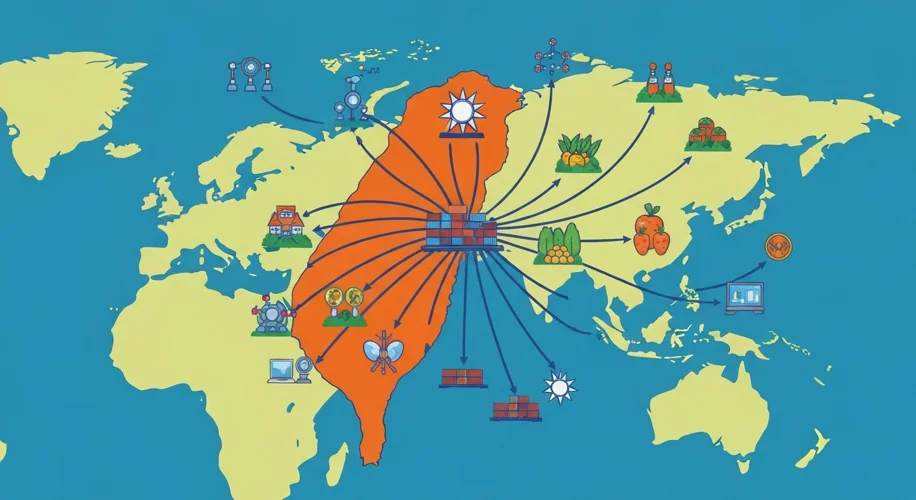The story of Taiwan’s global economic journey is a testament to resilience, strategic adaptation, and an unwavering spirit of enterprise. From its early days as an agrarian society to its emergence as a powerhouse in high-tech manufacturing, Taiwan’s trade relations have been a dynamic force shaping its destiny and influencing the world.
For centuries, Taiwan, then known as Formosa, was an island largely overlooked by major global powers, its trade limited to regional interactions and the steady flow of agricultural goods. The Dutch, Spanish, and later the Japanese, all left their mark, introducing new crops and trade practices, but it was after World War II, and especially with the relocation of the Republic of China (ROC) government to the island in 1949, that Taiwan’s economic trajectory began to dramatically shift.
This period marked a crucial turning point. With a large influx of skilled personnel and capital, coupled with a strategic geopolitical position in the Cold War, Taiwan began to pivot from an agrarian economy to one focused on industrialization. The government’s “Land to the Tiller” policy, implemented in the early 1950s, not only aimed at social reform but also freed up capital for industrial investment. Simultaneously, a series of U.S.-backed economic development plans fostered an environment conducive to trade and manufacturing.
Early trade was characterized by the export of light industrial goods – textiles, plastics, and simple consumer electronics. These products, often produced in small, family-run factories, offered a cost-effective alternative to Western goods. However, the true transformation began in the 1970s and 1980s. Recognizing the limitations of low-cost manufacturing, Taiwan’s visionary leaders and entrepreneurs made a strategic leap into higher-value sectors, most notably semiconductors and information technology.

This era saw the rise of iconic Taiwanese companies like TSMC (Taiwan Semiconductor Manufacturing Company), which would go on to become the world’s largest contract chip manufacturer. This strategic focus on technology wasn’t accidental; it was the result of calculated government investment in research and development, the establishment of science parks, and a commitment to nurturing a highly skilled workforce.
Canada, for instance, has been a steady partner in Taiwan’s trade evolution. While not as large a market as the United States or Europe, Canadian trade with Taiwan has historically focused on resources and agricultural products from Canada, and increasingly, on sophisticated Taiwanese electronics and manufactured goods. The relationship has been characterized by mutual benefit, with Canada appreciating Taiwan’s technological prowess and Taiwan valuing Canada’s stable supply of raw materials and its open market.
Navigating the complex international landscape, particularly with the People’s Republic of China’s (PRC) rising influence, has been a constant challenge for Taiwan. The ROC government’s diplomatic isolation meant that official trade agreements were often difficult to secure. Instead, Taiwan cultivated informal trade relationships, leveraging its economic clout and the pragmatic interests of nations seeking its advanced technological products.
The signing of the World Trade Organization (WTO) agreement in 2002 was a significant milestone, granting Taiwan more formal access to global markets. However, the PRC’s continued assertion of sovereignty over Taiwan has led to a delicate balancing act, with many nations hesitant to engage in official government-to-government trade pacts.
Despite these geopolitical complexities, Taiwan’s trade policies have consistently prioritized economic pragmatism and global integration. The island has become a linchpin in global supply chains, particularly for semiconductors, which are essential for everything from smartphones and laptops to advanced medical equipment and defense systems.

The cultural underpinnings of Taiwan’s trade success are also noteworthy. A strong work ethic, a deep respect for education, and a remarkable capacity for innovation have been driving forces. Furthermore, the island’s democratic transition in the late 20th century fostered an environment of openness and transparency, which, while posing its own challenges, ultimately contributed to its economic stability and appeal to international partners.
Looking ahead, Taiwan’s trade relations continue to evolve. Facing increasing competition and the ever-present geopolitical sensitivities, Taiwan is focusing on diversifying its markets, strengthening its technological leadership, and exploring new avenues for economic cooperation. The island’s ability to adapt and innovate, as demonstrated throughout its history, suggests it will remain a vital player in the global economy for years to come.
The story of Taiwan’s trade is not just one of goods and services; it is a narrative of a nation that, against considerable odds, built a prosperous future through ingenuity, hard work, and a keen understanding of the interconnected global marketplace. From the fertile fields of its past to the cutting-edge factories of its present, Taiwan’s economic echoes resonate worldwide.

